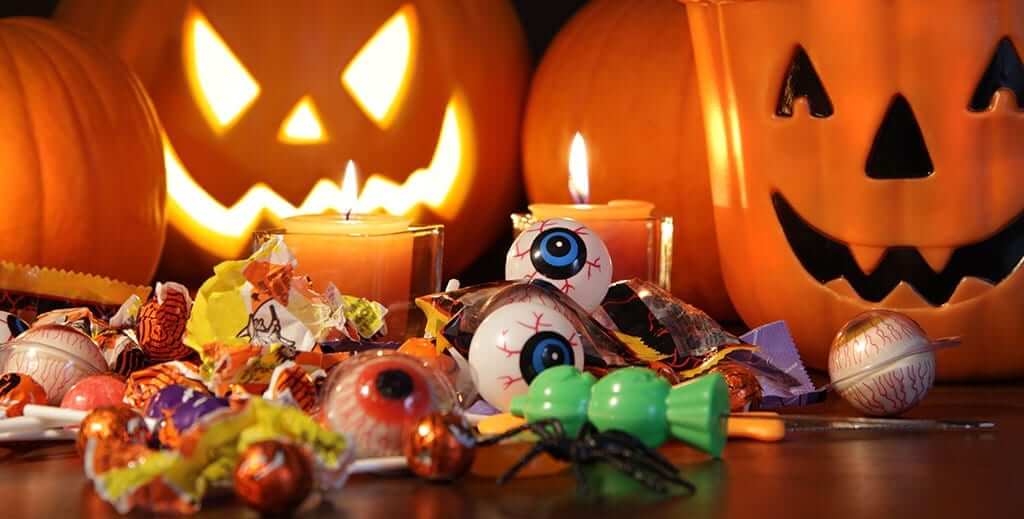Here comes the succession of holidays, “with the food holiday spiral” of Halloween, Thanksgiving, Christmas and New Year’s. According to USA Today, “4% of all candy consumed in the US is eaten on that single day called Halloween.” In the span of about 63 days, we attend holiday gatherings, fancy food focused parties, school bashes, office functions, neighborhood celebrations and family events. For some, it is difficult to “behave” all year but this seems to be the hardest time for most people with diabetes to avoid weight gain and blood sugar swings. It doesn’t have to be that way, since there are many things you can do to still enjoy the holiday season without losing diabetes control. Let’s examine what can be done:
Children or Adults with Type 1 Diabetes
According to The Joslin Diabetes Center, a leading diabetes clinic in Boston, “Children with diabetes can eat candy on Halloween, just like any child.” The important point is candy is considered a carbohydrate and must be worked into the overall meal plan. Insulin amounts may need to be adjusted during the holiday season. It is best to work with your endocrinologist/CDE to establish an eating plan including candy without jeopardizing your health and diabetes control.
Coming up with a plan prior to the holidays is important especially if the child is old enough to understand portions. Sugary candy such as jelly beans, gummy bears, candy corn, etc. contain no fiber and pure sugar gets into the bloodstream very quickly raising blood sugar. Candy can be substituted for other lunch box carbohydrates such as chips or fruit if the rest of the meal provides protein and fiber. Candy should be served in individual bite size servings or pre-portioned in baggies from a larger bag.
Candy collected on Halloween can be dealt with systemically. Children can sort through and choose which candies are their favorites. Excess individually wrapped candy can be donated to hospitals, schools, nursing homes, community centers, offices, homeless shelters or even troops overseas. Candy can be traded with friends and family for small toys, books, puzzles, sugar-free gum or money. Understand that you, as a parent, can help your child concentrate on other things besides candy during Halloween and the holidays. Help them focus their attention on costumes, arts and crafts projects, decorations for the house, or carving the perfect pumpkin. Think about an old-fashioned hay ride or apple bobbing contest. Go to a Halloween carnival or haunted house. Bake healthy homemade treats by adding nuts or nut butters for your kids. After carving the pumpkin, remove and roast the seeds with a dash of salt for a high fiber treat. Show them that you choose to give wholesome treats for your “Halloween give-away.”
Always buy candy in snack size. Teach them that chocolate candy contains more fat than carbohydrate and should not be used for hypoglycemia. Acquaint them with carbohydrate counting so they understand candy allotments. Examples of candy servings with 15 grams or one serving of a carbohydrate are, “1/2 package of mini-M&Ms, 11 candy corns, 3 small Tootsie Rolls or 15 Skittles.” Remember if your child is “walking the entire neighborhood” collecting candy, their blood sugar may go down from the exercise so consider that prior to increasing insulin doses. Even friends or family members without diabetes should “not go crazy” eating gobs of candy from the holiday stash. Make holiday treat eating a specific time and do not allow hourly candy grazing. Finally, encourage brushing teeth or at least rinsing with water after eating candy to better protect teeth.
What About People with Type 2 Diabetes?
There are no true “good foods verse bad foods”, but trying to focus on a balanced eating plan is still the best recommendation for the holidays. No specific diet is indicated, however understanding where foods fit in along with portion size is a good strategy. At a party spread, look for shrimp cocktail, mini turkey meatballs, Edamame, hummus and fresh carrot or pepper slices. Mixing treats with fat and protein including low-fat cheese sticks or unsalted nuts with a sprinkling of candy can be a reasonable way to enjoy Halloween. Eating fat like nuts, avocado, hummus (which takes longer to get into bloodstream) with candy may help the blood sugar remain stable without big swings. Eating dark chocolate with a higher the amount of cocoa, over 60-90%, has the least amount of carbohydrates which can have a smaller impact on your blood sugar changes.
Should I Only Focus on Sugar-Free Candies and Treats?
Sugar-free does not mean calorie-free or carbohydrate-free, so portions matter. Many people with diabetes think sugar-free is fair game and it is ok to consume huge amounts, but it’s not. Sugar-free foods contain sugar alcohols such as sorbitol, mannitol or maltitol which can cause gastric distress including stomach pains, bloating, gas and diarrhea.
What About Testing Blood Sugar During the Holidays?
You should be testing more frequently during the holidays to keep an eye on blood sugar trends. Especially, if you take insulin, you should test prior to making an insulin adjustment. Always check with your physician to come up with a specific plan for your insulin regulation. Make sure to stock extra blood sugar testing supplies so you do not run short.
Should I Weigh Myself and How Frequently?
During the holidays, it is unnecessary to weigh yourself daily but do get in the habit of checking your weighing at least weekly so 3 months later you do not see the average holiday weight gain of 12 pounds. It is much easier to lose a 2-pound weight gain by cutting back sooner than waiting until January 1st to start on 12.
Give Me More Help with Candy, Food & Alcohol Choices
Always purchase/choose mini-individualized candies to avoid temptation. A large chocolate bar is much more dangerous for portion control than a Chocolate Kiss or Dove square. Choose candy that contains nuts such as M&Ms with almonds or peanuts to “displace some of the candy” and add healthy fats. Read labels and compare. For example, Hershey’s Special Dark Chocolate with almonds has 7 less grams of sugar compared to the same serving size as Dove Dark Chocolate with almonds. Consider sucking a lollipop which takes longer to consume than eating a handful of jelly beans or candy corn which takes seconds to devour. Choose hard candies such as Jolly Ranchers to suck on instead of eating a handful of soft chewy caramels. If you need crunch, prepare and eat air popped popcorn instead of coated/flavored popcorn or Kettle Corn which normally has a sugar coating. Dip fresh fruit such as strawberries, chunks of fresh pineapple, slices of pear, cherries or banana slices into melted dark chocolate for a yummy and healthy treat. Most store bought dipped chocolate fruit contains “a layer of sugary fondant under the chocolate which adds calories, fat and carbohydrates.”

Watch out for holiday punch bowls and mulled wine filled with sweet mixes, empty calories and sugary juices. Avoid Eggnog which is full of saturated fat and high in calories. Consider a sparkling water or no sugar water enhancer instead. Coconut water can be a great substitute for sugary drinks.
Alcohol has no nutritional value just like candy. If you do drink alcohol, drink it in moderation and eat something while you are drinking. Many people with diabetes can develop hypoglycemia while drinking alcohol since it shuts the liver down from producing glucose. Stick to 12 ounces of light beer, 4-5 ounces of wine or plain liquor, and just 1 1/2 ounces of gin, vodka, scotch, whisky or rum. Mix with soda water, diet tonic, diet cola or drink plain on the rocks. Champagne and sparkling wine are good choices since they tend to be sipped rather than gulped. Add fresh, citrus slices such as lemons, oranges or limes for natural flavor and a festive look and feel. Drink out of fancy, crystal or colored glasses. Buy a jigger to measure alcohol. Look for low-calorie drink mixes made with Stevia for added cocktail flavors. “Skinny Girl cocktail mix” is one brand. Buy already flavored vodkas or rums such as lemon, pear or coconut as they have added flavor without extra calories and carbohydrates. Have a plain or sparkling water after each alcoholic beverage to stay hydrated because alcohol can cause dehydration which also raises blood sugars. Women and men over 65 are allowed only one drink and men under 65 are allowed two drinks daily. Remember that alcohol has no nutritional value and can interfere with many diabetes medications.
Where Does Exercise Fit In?
Sometimes we get overwhelmed during the holiday season and skip exercise entirely. But, this is the most important time to move. Exercise helps with stress reduction, weight gain and blood sugar control. If you already exercise, add another 20 minutes to your existing program 3 days a week. If you do not exercise, start slowly and work up to 30 minutes 4-5 days a week. Try to walk for 20-30 minutes after your main meal which can have a huge impact on blood sugars. You can also do 10-minute walks 3 times a day if you are in a time crunch. Just stay active. Weight and strength training builds muscle which will help keep your metabolic rate up to burn excess, holiday calories.
What Else Can I Do During the Holidays?
Do not skip meals and do not plan on eating more later in the day. Try to keep to your regular, balanced meal schedule as best you can. Stay super hydrated with plain water which will also help keep you less hungry. Make ‘self-time’ and do not “always be doing for others”. Learn the power of saying “no” to keep your sanity. Take mental breaks by deep-breathing or meditating and keep your sleep schedule as close to normal as possible. Do not indulge in holiday or specialty drinks such as Mocha Crème, Maple Pecan or Pumpkin Spice latte because these are full of calories, sugar and fat. Add a dash of cinnamon, a cinnamon stick, or almond, vanilla or peppermint extract to give coffee the holiday sensation. Try to purchase flavored coffees such as hazelnut, with no added sugar, carbs or calories. You can easily find them in groceries and big box stores. Stay away from candied fruit, dry fruit or fruit cakes and focus on fresh fruit in moderation. Do not forget to avoid excess sodium which may cause bloating, add water weight and raise blood pressure. Take fresh air breaks even when it gets chilly if you dress properly. Get a flu shot if you have not already.
These suggestions will help keep your resistance up to maintain your health during the holidays. Do not let anyone “guilt” you on the holidays, including yourself, about what you should or should not be eating or drinking because this just adds more stress and anger. If all else fails, get back to your plan the very next day and do not struggle with yesterday. Remember, right around the corner comes Valentine’s Day, St Patrick’s Day, Easter, birthdays and every other reason to start celebrating again! Enjoy but don’t over-indulge.
Have a question or comment? Then post below, no registration required. I would love to hear from you!
NOTE: Consult your Doctor first to make sure my recommendations fit your special health needs.








Leave A Comment